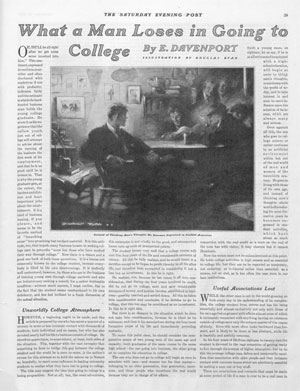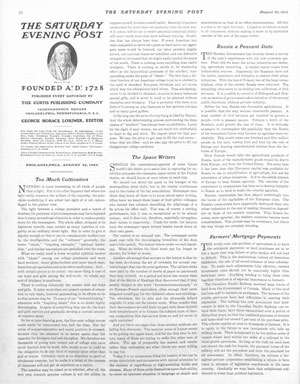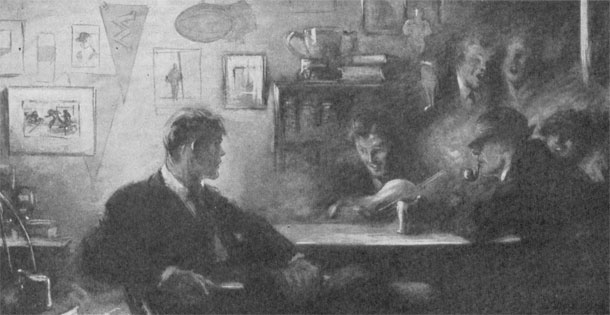You won’t get many people interested in discussing “the problems of higher education” until you bring up the trillion dollars. That’s the amount that America’s students now owe on their college tuition.
It’s hard to comprehend how much money $1,000,000,000,000 is. Consider this: It’s more than twice the amount, adjusted for inflation, that America paid to build its vast interstate highway system.
That’s a lot of money to repay. And with today’s sluggish economy and unemployment, more than one economist is losing sleep over whether we’ll ever clear that debt.
It’s no surprise that higher education is starting to draw the same amount of media attention, and criticism, as other big businesses. Critics are now challenging college’s admission policies, the merit of high-prestige universities, the need for traditional college lecture, and, of course, the cost.

Criticizing higher education is nothing new. Back in 1920, a Post article entitled “What a Man Loses in Going to College,” questioned whether higher education wasn’t a handicap to young men and women. “The average college man [loses] association with older people and that intimate contact with concrete issues which are absolutely essential in making a man out of boy stuff,” wrote E. Davenport.
“Instead of thinking men’s thoughts about a world during his most formative years, [the student] becomes engrossed in student activities, which have about as much connection with the real world as a wart on the end of the nose has with vision; it may obscure but it cannot illuminate.”
The author also claimed that young men, after spending four years among a juvenile cohort, became apathetic, vain, egotistical, argumentative, unreliable, and addicted to slang.
The Post editors also held a low opinion of college training. In a 1923 editorial, editors argued that a four-year degree could be earned in half the time if only students were taught a capacity for drudgery and self-discipline. Instead, colleges bred effete snobs. “We see thousands of young men turned out of college who have never learned how to work, who would scorn to yield to the obligation to do any kind of manual labor other than golf or tennis.”

By 1927, Albert W. Atwood claimed colleges were lowering their standards to admit mediocre and marginally intelligent scholars. He quoted criticism from the Association of University Professors, which sounds as if it could be written today: “When a university numbers its students by the thousands and the tens of thousands, when it admits almost anybody and teaches almost anything, when its classrooms are manned, as is inevitable, by inferior teachers, whenever endowment or appropriation must be sought in a vain effort to keep pace with its numerical growth, when each tries to outstrip its rivals in the externals and trappings of education, then the very character of the university is bound to change for the worse.”
In 1938, Dr. Robert M. Hutchins, the University of Chicago’s president, added his criticism. In “Why Go to College?” he admitted that higher education was often used as a dumping ground for young people. It was where some parent sent their children to get them out of the house for four years, and where young men and women went to avoid adulthood and responsibility.
Twenty years later, a journalism professor at the University of Indiana claimed colleges had become little more than marriage mills and fun factories. In “Are We Making a Playground Out of College?” Jerome Ellison wrote that colleges had developed a “Second Curriculum is that odd mixture of status hunger, voodoo, tradition, lust, stereotyped dissipation, love, solid achievement, and plain good fun sometimes called ‘college life.’ It drives a high proportion of our students through college chronically short of sleep, behind in their work, and uncertain of the exact score in any department of life.”
In 1965, Dr. Hutchins returned to the Post, this time declaring “Colleges Are Obsolete.” Higher education, he wrote, had become an industry concerned with numbers, not values. Colleges were only concerned with helping students amass the right number of semester hours for graduation. They couldn’t help students become more intelligent because they were no longer intellectual communities “thinking together about important things.” Instead, the campus had become just a collection of isolated specialties. “The student is never compelled to put together what the specialists have told him, because he is examined course by course by the teacher who taught the course.”
Hutchins’ article touches on the ultimate question of college: “Do our colleges help their students become more intelligent? The answer is, on the whole, no.”
Americans expect a college education to do something important, valuable, and lasting for a student. It’s difficult to assess whether a student is more intelligent after graduation. Let’s consider the value of college by a more practical measure: How much more can a graduate earn?
By this standard, college is still doing its job. Recent labor statistics from 2013 show that average Americans earned almost twice as much per hour if they had a four-year degree.
However, every college student must still individually solve the following problem: Does this earning advantage, extended over a 20-year career exceed the investment of four years and a pre-interest cash value of $18,000 to $46,000?
Become a Saturday Evening Post member and enjoy unlimited access. Subscribe now




Comments
How can I find a copy of the story “The Avenging Texans” published serially by you in 1954 or the original book by Alan McMay. Thank you
Roberta Fleming
9300 Chisholm Rd.
Pensacola FL 32514
850-476-3933
The question/debate of the worth of college (or not) goes back much further than I realized because of this article. I know the POST did a feature examining this in 1962, so it’s something whose legitimacy has never really stopped being in question.
In the next to last paragraph there’s the link that’s the college industry’s biggest trump card: their bellowing Orwellian screen both promising all that money, and (today) boldly psychologically bullying/ terrorizing every student that they HAVE to go—-no matter what.
The whole college system is largely still rooted in the 19th century, and all of the ever increasing the pressure to go seems like it’s based on the fact they’re afraid it’s only a matter of time before the whole Ivory Tower comes crashing down, probably when the student loan bubble finally bursts like the housing market did several years ago.
There’s so much cheating going on because so many students feel forced to go, get the degree—no matter what. It’s all about the colleges making tons of money and little else. If the number of students going to college because “they wanted an education”, they’d have very few students attending, and the colleges/universities know that—all too well!!
Also, if our country has more college grads than ever before today, than why is it SO thoroughly and utterly (I’ll be nice) messed up more than ever before, in almost every way imaginable? I’d LOVE to hear that one.
This is NOT to say there aren’t people who ARE there because they want to be, and NEED to be for their given profession, and WILL make the kind of money described above. There are—but not all that many.
The whole “lifetime earning advantage” shtick is discussed amongst all the other promises made by this industry in ‘The College Conspiracy’ right here on-line. It’s a one hour documentary that will have you hooked within the first minute, I promise. Simply put the name in, click, and watch.